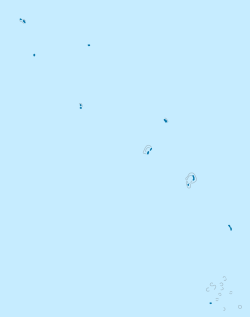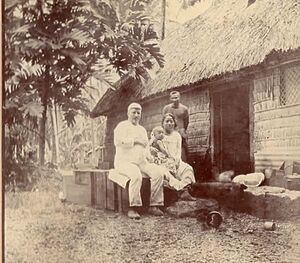Nui (atoll) facts for kids
Quick facts for kids
Nui
|
|
|---|---|

Aerial view of Nui
|
|

Map of the atoll
|
|
| Country | Tuvalu |
| Area | |
| • Total | 3.37 km2 (1.30 sq mi) |
| Population
(2017)
|
|
| • Total | 610 |
| • Density | 181.0/km2 (469/sq mi) |
| Demonym(s) | Nuian |
| ISO 3166 code | TV-NUI |
Nui is a small group of islands, called an atoll, in the Pacific Ocean. It is one of the nine districts of the country Tuvalu. Nui has a total land area of about 3.37 square kilometers. In 2017, about 610 people lived there.
The culture in Nui is traditionally organized around three main family groups. Most people live on the western side of the island called Fenua Tapu. In 2012, 321 people lived in the Alamoni – Maiaki area, and 221 people lived in Manutalake – Meang, which is also known as Tanrake. The local primary school for kids is called Vaipuna Primary School.
Contents
Geography of Nui
Nui is made up of at least 21 small islands, or islets. Some of the main ones are:
- Fenua Tapu
- Motupuakaka
- Pakantou
- Piliaieve
- Pongalei
- Talalolae
- Telikiai, also known as Meang
- Tokinivae
- Unimai
- And at least 12 other smaller islands.
The largest island is Fenua Tapu, which is also the most southern and eastern. It covers about 1.38 square kilometers. Other important islets include Telikiai (the most western), Tokinivae, Pongalei, Talalolae, Pakantou, Unimai, and Piliaieve.
Languages Spoken on Nui
The people of Nui speak two main languages. They speak Gilbertese language, which is the language of Kiribati. They also speak Tuvaluan, which is the official language of Tuvalu. This is because the ancestors of the people of Nui came from both Samoa and the Gilbert Islands (now Kiribati).
Early History of Nui
The first time Europeans saw Nui was on January 16, 1568. A Spanish explorer named Álvaro de Mendaña y Neyra discovered it. He named it Isla de Jesús, which means "Island of Jesus" in Spanish. He named it this because he found it the day after a Christian holiday called the Feast of the Holy Name.
Mendaña wrote that the island was small, about six leagues (around 33 kilometers) around. It was full of trees, like palm trees. He saw reefs around the north and south sides. He also noted that the island looked like two ships with trees in the middle.
When Mendaña's ship got closer, they saw people living on the island. Five canoes came near his ship. The people in the canoes raised their paddles and went back to shore. Mendaña tried to signal them with a white cloth to get them to return, but they just put up their own signals on the shore. At night, when Mendaña's ship showed a light, the islanders lit a fire. When the ship's light went out, their fire went out too.
Mendaña's pilot, Hernán Gallego, described the native people as "mulattoes." Another person on the trip, Pedro Sarmiento de Gamboa, said the island had a "large fishery," meaning lots of fish. It was getting late, so Mendaña decided to wait until morning to land. However, a strong storm blew up overnight, and they could not get back to the island.
Later, on June 14, 1825, a Dutch ship called the Maria Reijgersbergen found Nui. They named the main island, Fenua Tapu, Nederlandsch Eiland, which means "Dutch Island." The atoll has also been called Egg Island or Netherland Island.
The number of people living on Nui between 1860 and 1900 was estimated to be around 250 to 300. Kirisome was an important pastor on Nui for a long time, from 1865 to 1899.
Martin Kleis was a trader who lived on Nui in the late 1800s. He sold copra (dried coconut meat) to a company called Henderson and Macfarlane. The famous photographer Thomas Andrew visited Nui around 1885–86.
Nui got its own Post Office around 1919. A weather station was set up there in 1941 to help track the climate.
Traditional Canoes of Nui
The traditional outrigger canoes from Nui are called paopao. These canoes are special because they have an indirect way of attaching the outrigger. The hull, or body of the canoe, is the same at both ends, so there isn't a clear front or back. These canoes were made to be sailed inside the calm lagoon of Nui. The poles that connect the main canoe to the outrigger are longer than those on canoes from other islands. This design made the Nui canoe more stable when a sail was used.
Bogin te Ieka: Day of the Flood
Every year on February 16, people on Nui celebrate Bogin te Ieka, which means "Day of the Flood." This day remembers a big Tsunami that hit the island on that date in 1882.
Impact of Cyclone Pam in 2015
In March 2015, Nui was hit by strong storm surges from Cyclone Pam. These surges caused a lot of damage to homes, crops, and other important buildings. By March 22, 71 families, which was 40 percent of the island's population, had to leave their homes. They stayed in evacuation centers or with other families. A report on March 30 said that Nui was the most damaged of the central islands. About 90% of the crops on Nui were destroyed by the cyclone. Health teams visited Nui and other affected islands to help the people.
Nui's Government Representatives
In the 2019 general election, which happened on September 9, 2019, two people were re-elected to represent Nui in the country's parliament. These representatives were Puakena Boreham and Mackenzie Kiritome. They continue to serve the people of Nui.
Notable People from Nui
Many important people have come from Nui:
- Sir Iakoba Italeli (GCMC) served as the Governor-General of Tuvalu starting in 2010. Before that, he was a Minister for Education, Sports, and Health, representing Nui in the Parliament.
- Alesana Kleis Seluka (MBE, CBE) is a medical doctor. He has also represented Nui in parliament. He was the Minister of Finance and Economic Planning from 1996 to 1999, and Minister of Health from 2001 to 2006.
- Isaia Taeia Italeli was the Minister for Natural Resources. He held this position until he passed away in 2011.
- Pelenike Isaia became the second woman ever to be a member of the Parliament of Tuvalu. She was elected in a special election after her husband, Isaia Taeia Italeli, passed away. She represented Nui until the 2015 Tuvaluan general election.
- Mamao Keneseli is a leader in community development on Nui. In 1990, she started helping to run a women's handicraft center. There, she taught women how to improve their skills and earn money. From 2010 to 2017, she was the director of the Matapulapula Women's Group.
See also
 In Spanish: Nui para niños
In Spanish: Nui para niños






